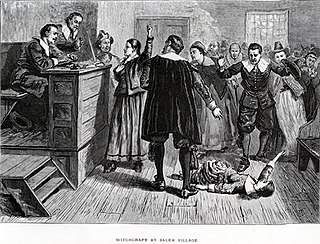
The Salem witch trials were a series of hearings and prosecutions of people accused of witchcraft in colonial Massachusetts between February 1692 and May 1693. More than 200 people were accused. Thirty people were found guilty, 19 of whom were executed by hanging. One other man, Giles Corey, died under torture after refusing to enter a plea, and at least five people died in jail.
John Hathorne was a merchant and magistrate of the Massachusetts Bay Colony and Salem, Massachusetts. He is best known for his early and vocal role as one of the leading judges in the Salem witch trials.
John Proctor, Jr. was a landowner in the Massachusetts Bay Colony. He was the son of John Proctor Sr. (1594–1672) and Martha Harper (1607–1667). John and his 3rd wife were tried on August 5, 1692. He was hanged on August 19, 1692 in Salem Village, Massachusetts Bay Colony during the Salem Witch Trials after being falsely accused and convicted of witchcraft.
Elizabeth Proctor was convicted of witchcraft in the Salem Witch Trials of 1692. She was the wife of John Proctor, who was convicted and executed.

Bridget Bishop was the first person executed for witchcraft during the Salem witch trials in 1692. Nineteen were hanged, and one, Giles Corey, was pressed to death. Altogether, about 200 people were tried.
Ann Foster was an Andover widow accused of witchcraft during the Salem witch trials.
Rev. Francis Dane was an English minister who was active in Andover, Massachusetts in the latter half of the 17th century. He was baptized in Bishop's Stortford, England, where it is possible he was also born. He is notable in the history of Colonial America for publicly opposing and consequently entangling his family in the Salem witch trials that took place in Massachusetts beginning in 1692.

Mercy Lewis was an accuser during the Salem Witch Trials. She was born in Falmouth, Maine. Mercy Lewis, formally known as Mercy Allen, was the child of Philip Lewis and Mary (Cass) Lewis.
Thomas Oliver was the second husband of Bridget Bishop, who on 10 June 1692 became the first victim of the Salem witch trials. He is a major link in the old and well-known theory that his widow, Bridget Bishop, was executed on trumped up charges because her in-laws were jealous of what she had inherited from him. Upham's History of the Salem Witchcraft Trials makes clear that her marriage to Thomas Oliver is a determining factor in the witchcraft prosecution of Bridget Oliver Bishop.

Jonathan Corwin was a New England merchant, politician, and magistrate. He is best known as one of the judges involved in the Salem witch trials of 1692, although his later work also included service as an associate justice of the Massachusetts Superior Court of Judicature, the highest court of the Province of Massachusetts Bay.
This timeline of the Salem witch trials is a quick overview of the events.

Capt. John Alden Jr. was an American soldier, politician, merchant, and sailor. He was a well-known public figure in his time but is now chiefly remembered as a survivor of the Salem witch trials, of which he wrote a much quoted and studied account.

Sarah Wildes was wrongly convicted of witchcraft during the Salem witch trials and was executed by hanging. She maintained her innocence throughout the process, and was later exonerated. Her husband's first wife was a member of the Gould family, cousins of the Putnam family, the primary accusers, and court records document the family feuds which led to her persecution.

Samuel Wardwell was a man accused of witchcraft during the Salem witch trials of 1692. He was executed by hanging on September 22, 1692, along with Alice Parker, Martha Corey, Mary Eastey, Ann Pudeator, Mary Parker, Wilmot Redd, and Margaret Scott.
Abigail Faulkner, sometimes called Abigail Faulkner Sr., was an American woman accused of witchcraft during the Salem witch trials in 1692. In the frenzy that followed, Faulkner's sister Elizabeth (Dane) Johnson (1641-1722), her sister-in-law Deliverance Dane, two of her daughters, two of her nieces, and a nephew, would all be accused of witchcraft and arrested. Faulkner was convicted and sentenced to death, but her execution was delayed due to pregnancy. Before she gave birth, Faulkner was pardoned by the governor and released from prison.
Sarah Cloys/Cloyce was among the many accused during Salem Witch Trials including two of her older sisters, Rebecca Nurse and Mary Eastey, who were both executed. Cloys/Cloyce was about 50-years-old at the time and was held without bail in cramped prisons for many months before her release.

Elizabeth Booth was born in 1674 and was one of the accusers in the Salem Witch Trials. She grew up in Salem, Massachusetts, as the second eldest of ten children. When she was sixteen she was accused of being a witch. When she was eighteen, she began accusing people of practicing witchcraft, including John Proctor, Elizabeth Proctor, Sarah Proctor, William Proctor, Benjamin Proctor, Woody Proctor, Giles Corey, Martha Corey, Job Tookey, and Wilmont Redd. Five of these people were executed due to Booth's testimony. Elizabeth Proctor would have been executed as well if she was not pregnant. After the Witch Trials, Booth married Israel Shaw on December 26, 1695, and had two children named Israel and Susanna. Booth's death date is unknown.

Martha Carrier was a Puritan accused and convicted of being a witch during the 1692 Salem witch trials.

Abigail Barker was among those accused of witchcraft during the Salem witch trials of 1692.